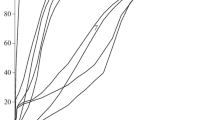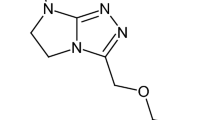Abstract
The thermal hazard of a series of quinoxaline 1,4-di-N-oxide derivatives, designed to act as prodrugs, whose chemical structure undergoes a very rapid decomposition, has been evaluated. The fusion and thermal decomposition of the compounds have been studied by thermogravimetry, differential scanning calorimetry, and mass spectrometry (MS-DIP). The results obtained indicate that the decomposition process from the loss of one of the oxygens linked to a nitrogen of the quinoxaline involves the release of a large quantity of vapor in a very small time interval. The enthalpy is higher than 300 J g−1; in some cases, it is around 1000 J g−1.





Similar content being viewed by others

References
Bestraten M. Nota Técnica de Prevención, NTP 302 “Reactividad e inestabilidad química: análisis termodinámico preliminar” Ministerio de Trabajo y Asuntos Sociales. España. 1999.
Calvet S. Nota Técnica de Prevención, NTP 527 “Reacciones químicas exotérmicas (I): factores de riesgo y prevención” Ministerio de Trabajo y Asuntos Sociales. España. 1999.
You ML, Tseng JM, Liu MY, Shu CM. Runaway reaction of lauroyl peroxide with nitric acid by DSC. J Therm Anal Calorim. 2010;102:535–9.
Hsueh KH, Chen WC, Liu SH, Shu CM. Thermal parameters study of 1,1-bis(tert-butylperoxy)cyclohexane at low heating rates with differential scanning calorimetry. J Therm Anal Calorim. 2014;118:1675–83.
Cheng SY, Tseng JM, Lin SY, Gupta JP, Shu CM. Runaway reaction on tert-butyl peroxybenzoate by DSC test. J Therm Anal Calorim. 2008;93:121–6.
McIntosh RD, Waldram SP. Obtaining more, and better, information from simple ramped temperature screening tests. J Therm Anal Calorim. 2003;73:35–52.
Tsai YT, Cao CR, Chen WT, Chou WL, You ML. Using calorimetric approaches and thermal analysis technology to evaluate critical runaway parameters of azobisisobutyronitrile. J Therm Anal Calorim. 2015;122:1151–7.
Mathieu D. Significance of theoretical decomposition enthalpies for predicting thermal hazards. J Chem. 2015; Article ID 158794: 1:12.
Townsend I. Basic strategy for the thermal stability assessment of pharmaceutical synthetic intermediates and products. J Therm Anal Calorim. 1991;37:2031–66.
Anderson H, Mentel J. Adiabatic decomposition kinetics by non-linear optimization. J Therm Anal Calorim. 1994;41:471–81.
Ende DJA, Ripin DHB, Weston NP. Thermal stability investigation of pyridine substituted tosyl oximes. Thermochim Acta. 2004;419:83–8.
Duh YS, Yo JM, Lee WL, Kao CS, Hsu JM. Thermal decompositions of dialkyl peroxides studied by DSC. J Therm Anal Calorim. 2014;118:339–47.
Lv JY, Chen WH, Chen YT, Yan JJ. Thermal risk evaluation on decomposition processes for four organic peroxides. Thermochim Acta. 2014;589:11–8.
Liu SH, Chen YC, Hou HY. Thermal runaway hazard studies for ABVN mixed with acids or alkalines by DSC, TAM III, and VSP2. J Therm Anal Calorim. 2015;122:1107–16.
Hou HY, Duh YS, Lin WH, Shu CM. Reactive incompatibility of cumene hydroperoxide mixed with alkaline solutions. J Therm Anal Calorim. 2006;85:145–50.
Kulkarni PB, Purandare GN, Nair JK, Talawar MB, Mukundan T, Asthana SN. Synthesis, characterization, thermolysis and performance evaluation studies on alkali metal salts of TABA and NTO. J Hazard Mater. 2005;119(53):61.
Carta A, Corona P, Loriga M. Quinoxaline 1,4-dioxide: a versatile scaffold endowed with manifold activities. Curr Med Chem. 2005;12:2259–72.
Vicente E, Villar R, Pérez-Silanes S, Aldana I, Goldman RC, Monge A. Quinoxaline 1,4-di-N-oxide and the potential for treating tuberculosis. Infect Dis Drug Targ. 2011;11:196–204.
Moreno E, Ancizu S, Perez-Silanes S, Torres E, Aldana I, Monge A. Synthesis and antimycobacterial activity of new quinoxaline-2-carboxamide 1,4-di-N-oxide derivatives. Eur J Med Chem. 2010;45:4418–26.
Ancizu S, Moreno E, Solano B, Villar R, Burguete A, Torres E, Perez-Silanes S, Aldana I, Monge A. New 3-methylquinoxaline-2-carboxamide 1,4-di-N-oxide derivatives as anti-Mycobacterium tuberculosis agents. Eur J Med Chem. 2010;18:2713–9.
Torres E, Moreno E, Ancizu S, Barea C, Galiano S, Aldana I, Monge A, Perez-Silanes S. New 1,4-di-N-oxide-quinoxaline-2-ylmethylene isonicotinic acid hydrazide derivatives as anti-Mycobacterium tuberculosis agents. Bioorg Med Chem Lett. 2011;221:3699–703.
Torres E, Moreno E, Galiano S, Devarapally G, Crawford PW, Azqueta A, Arbillaga L, Varela J, Birriel E, Di Maio R, Cerecetto H, Gonzalez M, Aldana I, Monge A, Perez-Silanes S. Novel quinoxaline 1,4-di-N-oxide derivatives as new potential antichagasic agents. Eur J Med Chem. 2013;66:324–34.
Millar RW, Philbin SP, Claridge RP, Hamid J. Studies of novel heterocyclic insensitive high explosive compounds: pyridines, pyrimidines, pyrazines and their bicyclic analogues. Propell Explos Pyrotech. 2004;29:81–91.
Tsai YT, Lin SY, Tong JW, Chen WC, Chen WT, Shu CM. Incompatible hazard investigation of a cycloaliphatic epoxy resin using green analytical method. J Therm Anal Calorim. 2015;122:1135–41.
Author information
Authors and Affiliations
Corresponding author
Rights and permissions
About this article
Cite this article
Lizarraga, E., Zabaleta, C. & Palop, J.A. Thermal behavior of quinoxaline 1,4-di-N-oxide derivatives. J Therm Anal Calorim 127, 1655–1661 (2017). https://doi.org/10.1007/s10973-016-5632-2
Received:
Accepted:
Published:
Issue Date:
DOI: https://doi.org/10.1007/s10973-016-5632-2



